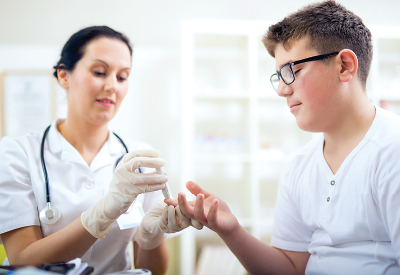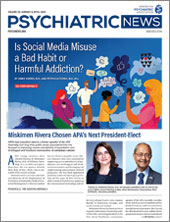Survey Finds Poor Compliance With Guidelines For Monitoring SGAs in Kids
Abstract
Less than 20 percent of the child psychiatrists surveyed said they adhere to recommendations to routinely monitor the fasting blood glucose and lipid levels, body mass index, and abnormal involuntary movements of children on second-generation antipsychotics.
Few child psychiatrists monitor children treated with second-generation antipsychotics (SGAs) in accordance with treatment guidelines, even though most are aware of those guidelines and agree with them, according to a survey published April 17 in Psychiatric Services in Advance.

“The low rate of monitoring, despite high levels of awareness of and agreement with the need to monitor, suggests that obstacles interfere with adopting these guidelines,” Jennifer McLaren, M.D., of Dartmouth-Hitchcock Medical Center and colleagues wrote. The findings of the survey suggest family resistance to monitoring may be one such barrier to compliance.
Youth treated with SGAs are known to be at a greater risk of weight gain, developing type 2 diabetes, and elevated cholesterol. In 2004, APA and the American Diabetes Association published guidelines on screening and monitoring of patients on SGAs, which were endorsed by the American Academy of Child and Adolescent Psychiatry (AACAP) in 2011. The guidelines specify routine monitoring of fasting blood glucose, fasting lipid profiles, body mass index (BMI), and abnormal involuntary movements (AIMs) prior to and periodically after initiating SGAs.
McLaren and colleagues sent the survey to 4,144 working email addresses of child psychiatrists throughout the United States who were registered members of AACAP, excluding psychiatrists in training, between December 2012 and February 2013.
Of the 1,314 psychiatrists who responded, over 95 percent reported they were aware of the guidelines for monitoring children and adolescents on SGAs. Fewer respondents said they agreed with the recommendations—agreement rates ranged from 69 percent for fasting lipids to 80 percent for glucose, 89 percent for AIMs, and 91 percent for BMI monitoring. Less than 20 percent of those surveyed said they had adopted and adhered to the SGA monitoring guidelines.
Additional analysis revealed that psychiatrists who were in academic practice had greater monitoring of glucose, lipids, BMI, and AIMs. In contrast, a physician’s length of time in practice was inversely related to monitoring glucose, lipids, and BMI. Many of the psychiatrists surveyed (82 percent) reported that parents who forget to obtain laboratory tests were a barrier to obtaining fasting glucose and lipids. Other commonly cited barriers were parental resistance (52 percent) and children’s refusal to obtain the tests (63 percent).
“Potential interventions to improve adoption include education with audit and feedback directed at specific providers who have not adopted recommended monitoring practices, monitoring reminder systems, and family education to improve knowledge and attitudes about monitoring,” the authors wrote.
David Rettew, M.D., an associate professor of psychiatry at the University of Vermont who reviewed the report for Psychiatric News, said previous studies have found similar results, but the findings of the current survey are especially striking.
“What is a little surprising is that in the past these low numbers have come from reports that have actually looked objectively at whether these lab tests have been ordered,” he told Psychiatric News. Moreover, he said the results come from a voluntary self-report where presumably people might overreport compliance with the recommendations, and those who are not compliant would be less likely to respond.
(Rettew was co-author of a 2015 report in Pediatrics that found that prescribing patterns of antipsychotic medications for children and adolescents follow best practice guidelines approximately one-half of the time. Lack of adherence to guidelines was in most cases related to lack of metabolic monitoring, Rettew said, mirroring results from the present study.)
Rettew said the association of compliance with use of an electronic medical record (EMR) suggests that this might be one vehicle to improve monitoring. “Physicians who have EMRs tend to be bombarded with automatic messages that often have little clinical utility, but here is an area where an electronic alert could be very useful,” he said. “I know in my own practice that having a message tell me that a particular patient is ovedue for lab testing could be quite helpful, but right now that doesn’t happen.”
He said family resistance to lab monitoring found in the new study mirrors the experience of clinicians in practice. “Nobody likes getting their blood drawn but for some kids it can spark major anxiety and outbursts,” he said. “This presents a difficult dilemma for the treating clinician and it is important that patients and families be fully informed of the risks.” ■
“Monitoring of Patients on Second Generation Antipsychotics: A National Survey of Child Psychiatrists” can be accessed here.



